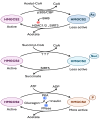Not Just an Alternative Energy Source: Diverse Biological Functions of Ketone Bodies and Relevance of HMGCS2 to Health and Disease
- PMID: 40305364
- PMCID: PMC12024914
- DOI: 10.3390/biom15040580
Not Just an Alternative Energy Source: Diverse Biological Functions of Ketone Bodies and Relevance of HMGCS2 to Health and Disease
Abstract
Ketogenesis, a mitochondrial metabolic pathway, occurs primarily in liver, but kidney, colon and retina are also capable of this pathway. It is activated during fasting and exercise, by "keto" diets, and in diabetes as well as during therapy with SGLT2 inhibitors. The principal ketone body is β-hydroxybutyrate, a widely recognized alternative energy source for extrahepatic tissues (brain, heart, muscle, and kidney) when blood glucose is sparse or when glucose transport/metabolism is impaired. Recent studies have identified new functions for β-hydroxybutyrate: it serves as an agonist for the G-protein-coupled receptor GPR109A and also works as an epigenetic modifier. Ketone bodies protect against inflammation, cancer, and neurodegeneration. HMGCS2, as the rate-limiting enzyme, controls ketogenesis. Its expression and activity are regulated by transcriptional and post-translational mechanisms with glucagon, insulin, and glucocorticoids as the principal participants. Loss-of-function mutations occur in HMGCS2 in humans, resulting in a severe metabolic disease. These patients typically present within a year after birth with metabolic acidosis, hypoketotic hypoglycemia, hepatomegaly, steatotic liver damage, hyperammonemia, and neurological complications. Nothing is known about the long-term consequences of this disease. This review provides an up-to-date summary of the biological functions of ketone bodies with a special focus on HMGCS2 in health and disease.
Keywords: GPR109A; HMGCS2; cancer; epigenetic modification; inflammation; ketoacidosis; ketone body transporters; loss-of-function mutations; neurodegeneration; β-hydroxybutyrate.
Conflict of interest statement
The authors declare no conflicts of interest.
Figures





Similar articles
-
HMGCS2 Mediation of Ketone Levels Affects Sorafenib Treatment Efficacy in Liver Cancer Cells.Molecules. 2022 Nov 18;27(22):8015. doi: 10.3390/molecules27228015. Molecules. 2022. PMID: 36432116 Free PMC article.
-
Empagliflozin improves mitochondrial dysfunction in diabetic cardiomyopathy by modulating ketone body metabolism and oxidative stress.Redox Biol. 2024 Feb;69:103010. doi: 10.1016/j.redox.2023.103010. Epub 2023 Dec 27. Redox Biol. 2024. PMID: 38160540 Free PMC article.
-
Fasting-induced HMGCS2 expression in the kidney does not contribute to circulating ketones.Am J Physiol Renal Physiol. 2022 Apr 1;322(4):F460-F467. doi: 10.1152/ajprenal.00447.2021. Epub 2022 Feb 28. Am J Physiol Renal Physiol. 2022. PMID: 35224990 Free PMC article.
-
Multi-dimensional Roles of Ketone Bodies in Fuel Metabolism, Signaling, and Therapeutics.Cell Metab. 2017 Feb 7;25(2):262-284. doi: 10.1016/j.cmet.2016.12.022. Cell Metab. 2017. PMID: 28178565 Free PMC article. Review.
-
Molecular Mechanisms for Ketone Body Metabolism, Signaling Functions, and Therapeutic Potential in Cancer.Nutrients. 2022 Nov 21;14(22):4932. doi: 10.3390/nu14224932. Nutrients. 2022. PMID: 36432618 Free PMC article. Review.
References
Publication types
MeSH terms
Substances
Grants and funding
LinkOut - more resources
Full Text Sources

